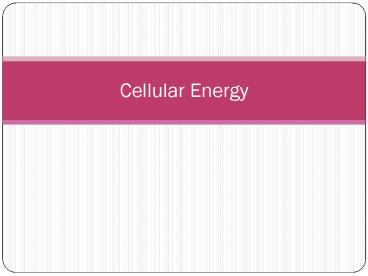Cellular Energy - PowerPoint PPT Presentation
1 / 32
Title:
Cellular Energy
Description:
Cellular Energy What is the difference between carbohydrates, lipids and proteins? Biological Molecules Functions Examples CARBOHYDRATES Store energy (quick energy ... – PowerPoint PPT presentation
Number of Views:112
Avg rating:3.0/5.0
Title: Cellular Energy
1
Cellular Energy
2
What is the difference between carbohydrates,
lipids and proteins?
Biological Molecules Functions Examples
CARBOHYDRATES Store energy (quick energy) Provide structural support for cells Glucose Fructose Sucrose Lactose Cellulose Starch Glycogen
LIPIDS Store energy (long-term) Provide barriers Chemical messengers Fats (energy) Oils (energy) Wax (barrier) Phospholipid (barrier) Cholesterol (messenger) Hormones (messenger)
PROTEINS Transport substances Speed up reactions Provide structural support Defense Hemoglobin (transport) Enzymes (speed up) Collagen (structural support) Antibodies (defense)
3
Classifying Carbohydrate Molecules
Category Example
MONOSACCHARIDE simple sugar One molecule of C6H12O6 Glucose Fructose
DISACCHARIDE Two monosaccharides linked together. Sucrose (table sugar) Lactose (milk)
POLYSACCHARIDE Three or more monosaccharides linked together. Starch (plants) Glycogen (animals) Cellulose (cell wall of plants)
4
(No Transcript)
5
There are 2 different pathways organisms can
perform respiration
The process of breaking down glucose into energy.
CELLULAR RESPIRATION
AEROBIC CELLULAR RESPRIATION
ANEROBIC CELLULAR RESPRIATION
No O2 present
O2 present
Humans
O2 glucose Energy CO2
Yeast
Alcohol Fermentation
Lactic Acid Fermentation
CO2 glucose energy alcohol
CO2 glucose energy lactic acid
6
Our cells need glucoseHow does a piece of bread
become glucose and find its way into our cells?
7
Step 1
- The saliva in the mouth will start to chemically
digest the polysaccharide bread (starch) into
disaccharides.
8
Step 2
- The wet ball of bread that is partially digested
will now be pushed down the esophagus and into
the stomach.
9
Step 3
- The stomachs acid and enzymes will digest the
polysaccharide and disaccharides remnants of
bread into glucose monosaccharides.
10
Step 4
- The bread has now been broken down into glucose.
It will be absorbed through the walls of the
intestines into the blood stream.
11
Step 5
- The bloods circulatory system will transport the
glucose to all parts of the body.
12
Step 6
- The glucose will be absorbed into the cell
through the process of diffusion. The glucose
will then enter the mitochondria and be broken
down for energy.
13
Purpose of Cellular Respiration
- To break the bonds of glucose molecules into
useable energy. - The energy is released in the form of ATP.
14
- Organelle Mitochondria
- Reactants (inputs) Oxygen, Glucose
- Products (outputs) ATP, CO2, Water
glucose
oxygen
Water
ATP
CO2
15
What type of organisms perform cellular
respiration?
- Autotrophs
- Heterotrophs
- An organism that can capture sunlight energy and
produce glucose (chemical energy). - AKA producer
- Examples plants, algae some bacteria
- An organism that obtains chemical energy from the
food it eats - AKA consumer, herbivore, carnivore, decomposer,
omnivore - Examples animals, fungi, most bacteria
16
Chemical Formula
Reactants (Into Mitochondria) Products (Out of Mitochondria)
Word Formula Glucose Oxygen Water Carbon Dioxide ATP Glucose Oxygen Water Carbon Dioxide ATP
Chemical Formula C6H12O6 O2 H2O CO2 ATP C6H12O6 O2 H2O CO2 ATP
17
What is ATP?
- ATP (Adenosine triphosphate) a biological
molecule that provides chemical energy for
cellular activities
Glucose
ATP
18
What is the function of ATP?
- ENERGY IS RELEASED WHEN
- The bond between the 2nd and 3rd phosphate groups
is broken, forming a molecule called ADP
(adenosine diphosphate).
19
- Anabolic ReactionS
- Catabolic Reactions
- Use energy to build larger molecules from smaller
molecules - Example Photosynthesis
- Release energy by breaking down larger molecules
into smaller molecules - Example
- Cellular Respiration
20
Photosynthesis
- Purpose Converts sunlight energy into chemical
energy (glucose). - Organelle Chloroplast
CHLOROPLAST
21
Reactants (Into the Chloroplast) Products (Out of the Chloroplast)
Word Formula Sunlight Water Carbon Dioxide Glucose Oxygen Sunlight Water Carbon Dioxide Glucose Oxygen
Chemical Formula Sunlight H2O CO2 C6H12O6 O2 Sunlight H2O CO2 C6H12O6 O2
22
How does the chloroplast absorb sunlight energy?
- Chlorophyll Pigments Molecules that can absorb
visible light waves. Below are the most common
pigments found in plants - Chlorophyll a
- Chlorophyll b
23
Chlorophyll Absorption
24
What are enzymes?
- ENZYMES are CATALYST proteins that help speed up
chemical reactions. The enzyme is does not get
used up during the reaction.
25
What is the purpose of enzymes?
12
- Enzymes are biological catalysts that lower the
activation energy needed to start a chemical
reaction inside living organisms . It allows the
reaction to proceed quickly. The enzyme can be
used again after each reaction.
26
Each type of enzyme has a very specific role.
13
Enzyme Name Job
Lipase Breaks down lipids (fats)
Peptidase Breaks down peptide ponds that hold amino acids together (proteins)
Lactase Breaks down lactose found in dairy products
Cellulase Breaks down cellulose found in cell walls
Pectinase Breaks down pectin found in cell walls
Polymerase Builds DNA
Rubisco Builds glucose molecules (a part of photosynthesis)
ATP Synthase Builds ATP molecules (a part of cellular respiration)
27
- Just like how each enzyme has a very specific
role, they each have a very specific shape
28
14
1. Substrate binds to the specific active site on
the enzyme.
2. Bonds of substrate change and form a new
product.
3. Products are released. The enzyme will now
attach to a new substrate.
29
(No Transcript)
30
Active Site Product Enzyme Substrate
15
Product
Substrate
Active Site
Enzyme
Enzymes A Fun Introduction https//www.youtube.co
m/watch?vXTUm-75-PL4featurerelated
31
How do factors such as temperature pH affect
enzyme activity?
16
If an enzyme is NOT in its normal temperature or
pH environment, the enzyme will DENATURE
(denaturation) The enzymes bonds and
physical structure breaks, causing the enzyme to
change shape. The active site is no longer
functional.
32
Denaturation































